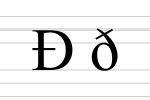The letter yogh (ȝogh) (Ȝ ȝ; Scots: yoch; Middle English: ȝogh) was used in Middle English and Older Scots, representing y (/j/) and various velar phonemes...
29 KB (2,997 words) - 18:56, 24 July 2024
for [g]. Instances of yogh were eventually replaced by ⟨j⟩ or ⟨y⟩ and by ⟨gh⟩ in words like night and laugh. In Middle Scots, yogh became indistinguishable...
66 KB (5,638 words) - 23:29, 25 August 2024
had passed into Old English, it developed into the Middle English letter yogh (Ȝ ȝ). Middle English, having reborrowed the familiar Carolingian g from...
3 KB (266 words) - 22:40, 21 March 2024
replaced the Middle English letter yogh (Ȝȝ), which developed from the letter G, ultimately from Semitic gimel. Yogh could also represent other sounds...
34 KB (3,240 words) - 07:15, 20 August 2024
similar letter in the Greek alphabet used to write the Bactrian language Yogh, Ȝ, a letter used in Middle English and Older Scots Wynn, Ƿ, another runic...
16 KB (1,486 words) - 01:13, 26 August 2024
developed into yogh ⟨Ȝ ȝ⟩, used in Middle English. Wynn was later replaced with the new letter ⟨w⟩, eth and thorn with ⟨th⟩, and yogh with ⟨gh⟩. Although...
39 KB (3,948 words) - 08:30, 29 July 2024
the German alphabet. The character came to be indistinguishable from the yogh (ȝ) in Middle English writing. Unicode assigns codepoints U+2128 ℨ BLACK-LETTER...
30 KB (2,841 words) - 19:12, 17 August 2024
/w/. (The letter 'w' had not yet been invented.) Replaced by w now. Ȝ ȝ Yogh, ȝogh or yoch /ˈjɒɡ/ or /ˈjɒx/, used for various sounds derived from /ɡ/...
32 KB (3,353 words) - 21:00, 24 August 2024
of elements of the Old English alphabet such as thorn <þ>, eth <ð>, and yogh <ʒ>. The substitution of visually similar typographic forms has led to some...
5 KB (652 words) - 23:44, 26 June 2024
melange The digraph ⟨gh⟩ (in many cases a replacement for the obsolete letter yogh, which took various values including /ɡ/, /ɣ/, /x/ and /j/) may represent:...
31 KB (2,724 words) - 23:54, 19 August 2024
letter Zeta Z z : Latin letter Z Ʒ ʒ : Latin letter Ezh Ȝ ȝ : Latin letter Yogh Ɜ ɜ : Latin letter reversed open E Ҙ ҙ : Cyrillic letter Dhe or Ze with descender...
7 KB (694 words) - 17:02, 17 July 2024
spelling of the name as Menȝies, using the letter ⟨ȝ⟩ (yogh). The current spelling arose when yogh fell out of use in the Scots language and was replaced...
6 KB (681 words) - 19:13, 15 July 2024
"L2/20-268: Revised proposal to add ten characters for Middle English to the UCS" (PDF). Digamma Eth Meldorf fibula Thorn (letter) Vend (letter) Yogh Ỽ...
6 KB (537 words) - 10:19, 6 July 2024
English manuscripts, this letter usually took its insular form ⟨ᵹ⟩ (see also: yogh). The [j] and [dʒ] pronunciations are sometimes written ⟨ġ⟩ in modern editions...
89 KB (8,225 words) - 14:56, 16 August 2024
into digraphs gh, ch, but in its early days some writers used it for yogh. Yogh dissolved in Scottish proper names to z due to its lower case equivalent...
3 KB (309 words) - 19:45, 2 August 2024
fallback representation is the numeral 3, or the Middle English character ȝ Yogh; neither are to be preferred to the genuine Egyptological characters. Written...
24 KB (2,495 words) - 14:03, 15 August 2024
Culzean Castle (/kʌˈleɪn/ kul-AYN, see yogh; Scots: Culzean, Culȝean, Colean) is a castle overlooking the Firth of Clyde, near Maybole, Carrick, in South...
13 KB (1,242 words) - 08:50, 25 July 2024
of elements of the Old English alphabet such as thorn <þ>, eth <ð>, and yogh <ʒ>. The substitution of visually similar typographic forms has led to some...
10 KB (972 words) - 07:59, 20 August 2024
of elements of the Old English alphabet such as thorn <þ>, eth <ð>, and yogh <ʒ>. The substitution of visually similar typographic forms has led to some...
17 KB (1,865 words) - 18:07, 31 July 2024
[məˈkɛŋjiː] in Scots, with the "z" representing the old Middle Scots letter, "ȝ" yogh. This is an anglicised form of the Scottish Gaelic MacCoinnich, which is...
13 KB (1,583 words) - 11:35, 4 April 2024
Wolfsangel, similar shape to the Eihwaz rune Mees, Bernard (2011). "The Yew Rune, Yogh and Yew". University of Leeds. p. 54. Odenstedt, Bengt (1990), On the Origin...
4 KB (437 words) - 19:07, 23 June 2024
Menȝies) arose for the same reason: the letter ⟨z⟩ was substituted for ⟨ȝ⟩ (yogh). Some other combinations of letters look similar, for instance rn looks...
15 KB (1,961 words) - 09:41, 19 August 2024
0350 Miscellaneous U+021C Ȝ 540 Latin Capital Letter Yogh · U+021D ȝ 541 Latin Small Letter Yogh U+021E Ȟ 542 Latin Capital Letter H with caron 0351 for...
157 KB (1,827 words) - 19:38, 25 August 2024
of elements of the Old English alphabet such as thorn <þ>, eth <ð>, and yogh <ʒ>. The substitution of visually similar typographic forms has led to some...
4 KB (442 words) - 18:13, 28 July 2024
used in several African languages Dram (unit) (ℨ) and Gothic font letter Z Yogh or Ȝ, letter used in Middle English and Middle Scots Gyfu or Gar (rune) Anglo...
16 KB (1,846 words) - 10:44, 11 August 2024
capital Ezh Uralic Phonetic Alphabet Ƹ ƹ Ezh reversed IPA (obsolete) Ȝ ȝ Yogh Middle English ꭠ Sakha Yat Yakut (historical) Þ þ Thorn Old English, Icelandic...
192 KB (1,070 words) - 20:46, 21 July 2024
Middle Scots letter, yogh, the pronunciation of which is almost identical to the original Norn sound, /hj/. When the use of the letter yogh was discontinued...
134 KB (13,202 words) - 05:56, 24 August 2024
þ (interchangeable with ð in manuscripts) corresponds to th. For ȝ, see Yogh. 1 - (Old English also had a separate dual, ġit ("ye two") etcetera; however...
63 KB (6,035 words) - 08:50, 15 August 2024
used for /z/ but may occur in some words as a substitute for the older ⟨ȝ⟩ (yogh) realised /jɪ/ or /ŋ/. For example: brulzie ("broil"), gaberlunzie (a beggar)...
72 KB (7,644 words) - 23:33, 25 August 2024





















